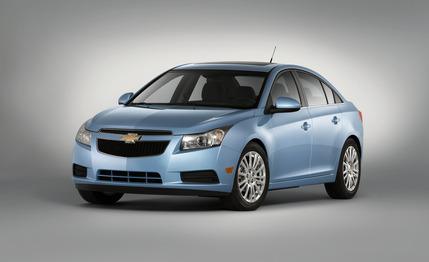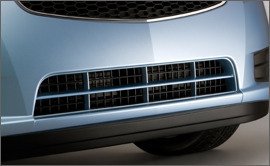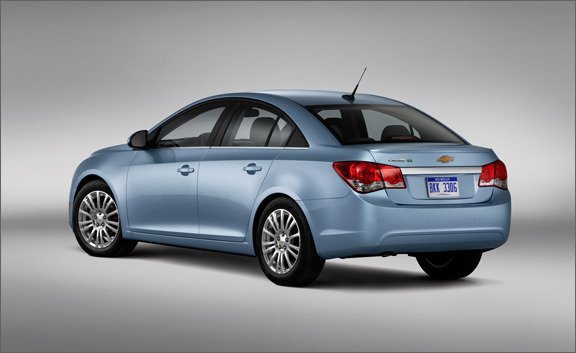
 First Drive Review
First Drive Review
The automotive landscape is bookended by those buyers who want their cars to be fun and those who want them to use as little fuel as possible. These two goals are usually at odds with each other, but every now and then, they can coexist peacefully. Unexpected case in point: the 2011 Chevrolet Cruze Eco, which improves on the Cruze’s fuel efficiency not through expensive and heavy hybrid technology but by enhancing aerodynamics, reducing mass, and optimizing the powertrain. Fortunately, all three measures improve driving enjoyment while they’re at it.
Slipping through the Air, and Looking Good Doing It
First, Chevrolet optimized the Eco’s aerodynamics by inconspicuously paneling off more of the upper grille than on other Cruze models and by adding motorized shutters to the lower air intake to close it off during high-speed cruising. Chevy also lowered the Eco 0.4 inch with springs borrowed from the Cruze’s optional sport suspension and smoothed airflow beneath the car with underbody panels. Finally, engineers fitted a thin spoiler to the trunk and installed a full-width air dam beneath the front fascia. The net result is a claimed 10-percent drop in aerodynamic drag, and the lower stance means less body roll in corners—not to mention a sportier look.


Auto Lipo: Hardly Left Any Scars
Like plastic surgeons performing spot liposuction on a skinny starlet, Chevy engineers cut mass in more than 40 separate operations, including removing the rear center armrest—and, strangely, the rear center headrest on manual-transmission cars—using thinner sheetmetal in selected components, and even reducing the length of weld flanges. Lacy forged 17-inch wheels wrapped in the Volt’s ultra-low-rolling-resistance tires were swapped in. They look good and, according to Chevy, drop 5.3 pounds of unsprung weight at each corner compared with the Cruze 1LT. Chevrolet reduced the capacity of the fuel tank of the manual-trans Eco from 15.6 to 12.6 gallons, which sounds a bit like cheating but maintains a highway range of more than 500 miles. The spec sheet certainly approves of these measures: The Cruze Eco undercuts the Cruze 1LT by more than 200 pounds. Less mass, of course, generally requires less fuel to move, and it often has a positive effect on handling, acceleration, and braking, too.
Eco: The Only Turbo Cruze with a Manual Transmission
Whereas the 1.4-liter turbocharged four-cylinder and the available six-speed automatic (a $1450 option) are essentially the same as those found in other Cruzes, the Eco makes available a six-speed manual—the only turbo Cruze to do so—in the interest of maximizing fuel economy. The auto-equipped Eco is more fuel efficient than its non-Eco counterpart, but to go farthest on a gallon of gas, the Eco manual—with taller ratios in the top four gears than other manual Cruzes—is the one to get. The EPA estimates that the manual Eco can travel 28 mpg in the city and 42 on the highway versus 26/37 for the automatic and a best of 24/36 for the regular Cruze.
That estimate sounds dreamy, but on a drive from Los Angeles to San Diego in a manual-equipped Eco, the (probably optimistic) trip computer showed an average of 43.8 mpg, with most of our cruising done at 80 mph with the air conditioning on and the engine loping along at 2500 rpm (the automatic-equipped Eco’s engine spun at 3000 rpm, which is more common for a small engine at high speed). Both Eco models feature a clutch-based, variable-displacement A/C compressor for reduced parasitic loss when the air isn’t on.


The manual Eco model’s super-tall gearing actually slows the car’s acceleration, with 0-to-60 now taking 9.8 seconds in our estimation. We don’t expect the auto-equipped car to waver from the 8.9 seconds we last recorded in a turbocharged Cruze. The low-rolling-resistance tires don’t seem to have a similar effect on handling and braking, though; from behind the wheel, the Eco feels nimbler and more responsive than other Cruzes. . It’s just that it is lighter, lower, and more fuel efficient. In other words, the Cruze Eco is a rare win-win for buyers seeking some fun as well as those wanting thrift.

